No matter which direction you look in the Universe, the view is basically the same if you look far enough. Our local neighborhood is populated with bright nebulae, star clusters, and dark clouds of gas and dust. There are more stars toward the center of the Milky Way than there are in other directions. But across millions, and billions, of light-years, galaxies cluster evenly in all directions, and everything starts to look the same. In astronomy, we say the Universe is homogeneous and isotropic. Put another way, the Universe is smooth.
Continue reading “The Universe is the Same, Everywhere We Look. Even More than Cosmologists Predicted”Complete and Total Mayhem in a Distant Galaxy Collision
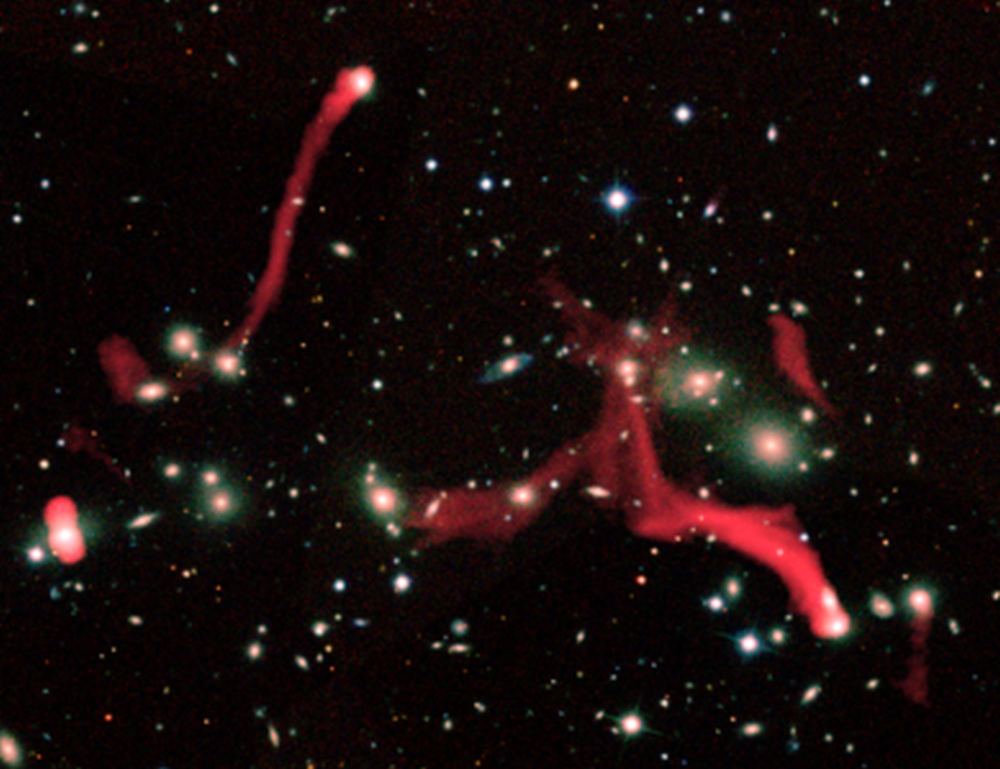
A cluster of galaxies is nothing trivial. The shocks, the turbulence, the energy, as all of that matter and energy merges and interacts. And we can watch all the chaos and mayhem as it happens.
A team of astronomers are looking at the galaxy cluster Abell 2255 with the European Low-Frequency Array (LOFAR) radio telescope, and their images are showing some never-before-seen details in this actively merging cluster.
Continue reading “Complete and Total Mayhem in a Distant Galaxy Collision”Astronomers See a Pileup of 14 Separate Galaxies in the Early Universe

Looking deep into the observable Universe – and hence, back to the earliest periods of time – is an immensely fascinating thing. In so doing, astronomers are able to see the earliest galaxies in the Universe and learn more about how they evolved over time. From this, they are not only able to see how large-scale structures (like galaxies and galaxy clusters) formed, but also the role played by dark matter.
Most recently, an international team of scientists used the Atacama Large Millimeter-submillimeter Array (ALMA) to observe the Universe when it was just 1.4 billion years old. What they observed was a “protocluster”, a series of 14 galaxies located 12.4 billion light-years away that were about to merge. This would result in the formation of a massive galaxy cluster, one of the largest objects in the known Universe.
The study which described their findings, titled “A massive core for a cluster of galaxies at a redshift of 4.3“, recently appeared in the journal Nature. The study was led by Tim Miller – an astronomer from Dalhousie University, Halifax, and Yale University – and included members from NASA’s Jet Propulsion Laboratory, the European Southern Observatory (ESO), Canada’s National Research Council, the Harvard-Smithsonian Center for Astrophysics, the National Radio Astronomy Observatory, and multiple universities and research institutions.
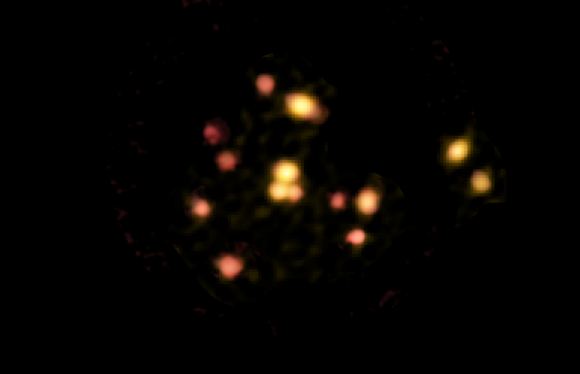
As they indicate in their study, this protocluster (designated SPT2349-56) was first observed by the National Science Foundation’s South Pole Telescope. Using the Atacama Pathfinder Experiment (APEX), the team conducted follow-up observations that confirmed that it was an extremely distant galactic source, which was then observed with ALMA. Using ALMA’s superior resolution and sensitivity, they were able to distinguish the individual galaxies.
What they found was that these galaxies were forming stars at rate 1,000 times faster than our galaxy, and were crammed inside a region of space that was about three times the size of the Milky Way. Using the ALMA data, the team was also able to create sophisticated computer simulations that demonstrated how this current collection of galaxies will likely grow and evolve over billion of years.
These simulations indicated that once these galaxies merge, the resulting galaxy cluster will rival some of the most massive clusters we see in the Universe today. As Scott Chapman, and astrophysicist at Dalhousie University and a co-author on the study, explained:
“Having caught a massive galaxy cluster in throes of formation is spectacular in and of itself. But, the fact that this is happening so early in the history of the universe poses a formidable challenge to our present-day understanding of the way structures form in the universe.”
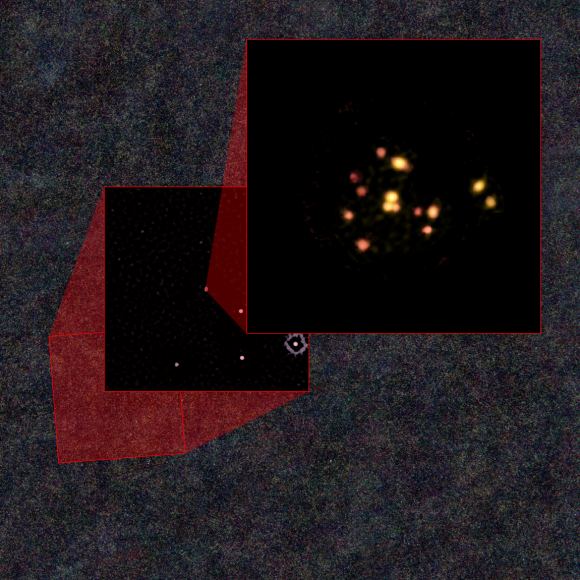
The current scientific consensus among astrophysicists states that a few million years after the Big Bang, normal matter and dark matter began to form larger concentrations, eventually giving rise to galaxy clusters. These objects are the largest structures in the Universe, containing trillions of stars, thousands of galaxies, immense amounts of dark matter and massive black holes.
However, current theories and computer models have suggested that protoclusters – like the one observed by ALMA – should have taken much longer to evolve. Finding one that dates to just 1.4 billion years after the Big Bang was therefore quite the surprise. As Tim Miller, who is currently a doctoral candidate at Yale University, indicated:
“How this assembly of galaxies got so big so fast is a bit of a mystery, it wasn’t built up gradually over billions of years, as astronomers might expect. This discovery provides an incredible opportunity to study how galaxy clusters and their massive galaxies came together in these extreme environments.”
Looking to the future, Chapman and his colleagues hope to conduct further studies of SPT2349-56 to see how this protoclusters eventually became a galaxy cluster. “ALMA gave us, for the first time, a clear starting point to predict the evolution of a galaxy cluster,” he said. “Over time, the 14 galaxies we observed will stop forming stars and will collide and coalesce into a single gigantic galaxy.”
The study of this and other protoclusters will be made possible thanks to instruments like ALMA, but also next-generation observatories like the Square Kilometer Array (SKA). Equipped with more sensitive arrays and more advanced computer models, astronomers may be able to create a truly accurate timeline of how our Universe became what it is today.
Are Little Blue Dots in the Hubble Frontier Fields Precursors to Globular Clusters?
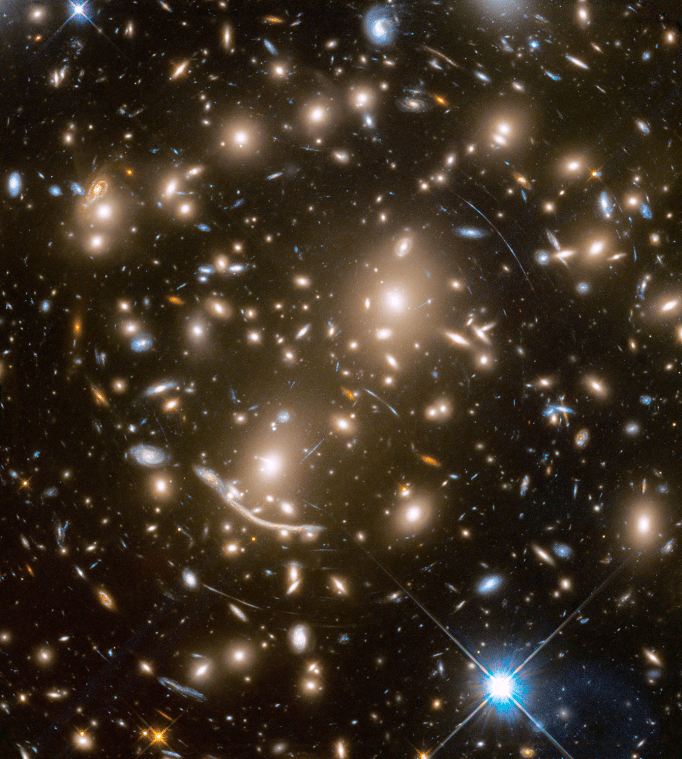
In 2012, the Hubble Space Telescope Frontier Fields program (aka. Hubble Deep Fields Initiative 2012) officially kicked off. The purpose of this project was to study the faintest and most distant galaxies in the Universe using the gravitational lensing technique, thus advancing our knowledge of early galaxy formation. By 2017, the Frontier Field program wrapped up, and the hard work of analyzing all the data it collected began.
One of the more interesting finds within the Frontier Fields data has been the discovery of low mass galaxies with high star formation rates. After examining the “parallel fields” for Abell 2744 and MACS J0416.1-2403 – two galaxy clusters studied by the program – a pair of astronomers noted the presence of what they refer to as “Little Blue Dots” (LBDs), a finding which has implications for galaxy formation and globular clusters.
The study which details their findings recently appeared online under the title “Little Blue Dots in the Hubble Space Telescope Frontier Fields: Precursors to Globular Clusters?“. The study team consisted of Dr. Debra Meloy Elmegreen – a professor of astronomy at Vassar College – and Dr. Bruce G. Elmegreen, an astronomer with the IBM Research Division at the T.J. Watson Research Center in Yorktown Heights.
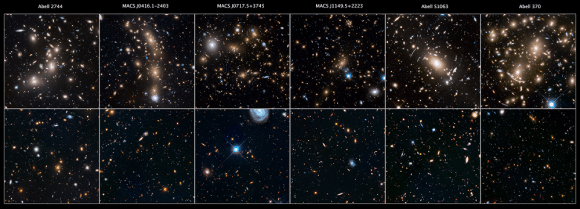
To put it simply, the Frontier Fields program used the Hubble Space Telescope to observe six massive galaxy clusters at optical and near-infrared wavelengths – with its Advanced Camera for Surveys (ACS) and Wide Field Camera 3 (WFC3), respectively. These massive galaxies were used to magnify and stretch images of remote galaxies located behind them which were otherwise too faint for Hubble to see directly (aka. gravitational lensing).
While one of these Hubble cameras would look at a galaxy cluster, the other would simultaneously view an adjacent patch of sky. These adjacent patches are known as “parallel fields”, otherwise faint regions that provide some of the deepest looks into the early Universe. As Dr. Bruce Elmegreen told Universe Today via email:
“The purpose of the HFF program is to take deep images of 6 regions of the sky where there are clusters of galaxies, because these clusters magnify background galaxies through the gravitational lens effect. In this way, we can see further than just with direct imaging of the sky alone. Many galaxies have been studied using this magnification technique. The clusters of galaxies are important because they are big mass concentrations which make strong gravitational lenses.”
This six galaxy clusters used for the sake of the project included Abell 2744, MACS J0416.1-2403 and their parallel fields, the latter of which were the focal point in this study. These and the other clusters were used to find galaxies that existed just 600 to 900 million years after the Big Bang. These galaxies and their respective parallels had already been cataloged using computer algorithms that automatically found galaxies in the images and determined their properties.
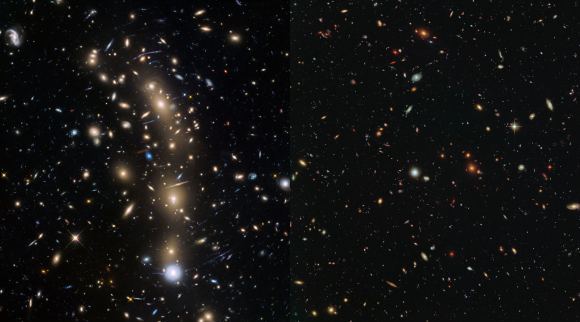
As the research duo go on to explain in their study, recent large-scale deep surveys have enabled studies of smaller galaxies at higher redshifts. These include “green peas” – luminous, compact and low mass galaxies with high specific star formation rates – and even lower-mass “blueberries”, small starburst galaxies that are a faint extension of the green peas that also show intense rates of star formation.
Using the aforementioned catalogues, and examining the parallel fields for Abell 2744 and MACS J0416.1-2403, the team went looking for other examples of low-mass galaxies with high star formation rates. The purpose of this was to measure the properties of these dwarf galaxies, and to see if any of their positions accorded with where globular clusters are known to have formed.
What they found was what they referred to as “Little Blue Dots” (LBSs), which are even lower-mass versions of “blueberries”. As Dr. Debra Elmegreen told Universe Today via email:
“When I was examining the images (there are about 3400 galaxies detected in each field), I noticed occasional galaxies that appeared as little blue dots, which was very intriguing because of Bruce’s previous theoretical work on dwarf galaxies. The published catalogs included redshifts and star formation rates and masses for each galaxy, and it turns out the little blue dots are low mass galaxies with very high star formation rates for their mass.”
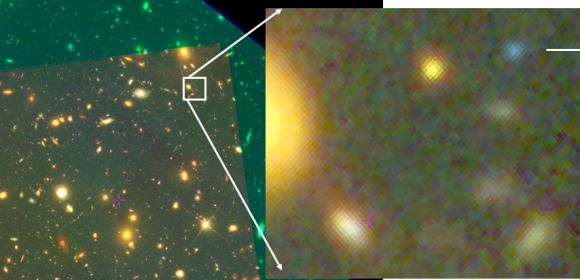
These galaxies didn’t show structure, so Debra and Bruce stacked the images of galaxies into 3 different ranges of redshift (which worked out to about 20 galaxies each) to create deeper images. “Still they showed no structure or faint extended outer disk,” said Debra, “so they are at the limit of resolution, with average sizes of 100-200 parsecs (about 300-600 light years) and masses of a few million times the mass of our sun.”
In the end, they determined that within these LBDs, star formation rates were very high. They also noted that these dwarf galaxies were very young, being less than 1% the age of the Universe at the time that they were observed. “So the tiny galaxies just formed,: said Bruce, “and their star formation rates are high enough to account for the globular clusters, maybe one in each LBD, when the star bursts in them wind down after a few tens of million years.”
Debra and Bruce Elmegreen are no strangers to high redshift galaxies. Back in 2012, Bruce published a paper that suggested that the globular clusters that orbit the Milky Way (and most other galaxies) formed in dwarf galaxies during the early Universe. These dwarf galaxies would have since been acquired by larger galaxies like our own, and the clusters are essentially their remnants.
Globular clusters are essentially massive star clusters that orbit around the Milky Way Halo. They are typically around 1 million Solar masses and are made up of stars that are very old – somewhere on the order of 10 to 13 billion years. Beyond the Milky Way, many appear in common orbits and in the Andromeda Galaxy, some even appear connected by a stream of stars.

As Bruce explained, his is a compelling argument for the theory that globular clusters formed from dwarf galaxies in the early Universe:
“This suggests that the metal-poor globular clusters are the dense remnants of little galaxies that got captured by bigger galaxies, like the Milky Way, and ripped apart by tidal forces. This idea for the origin of halo globular clusters goes back several decades… It would be only the metal-poor one that are like this, which are about half the total, because dwarf galaxies are metal poor compared to big galaxies, and they were also more metal poor in the early universe.”
This study has many implications for our understanding of how the Universe evolved, which was the chief aim of the Hubble Frontier Fields program. By examining objects in the early Universe, and determining their properties, scientists are able to determine how the structures that we are familiar with today – i.e. stars, galaxies, clusters, etc. – truly came from.
These same studies also allow scientists to make educated guesses about where the Universe is going and what will become of those same structures millions or even billions of years from now. In short, knowing where we’ve been lets us predict where we are headed!
Further Reading: arXiv
A Snapshot of a Galactic Crash
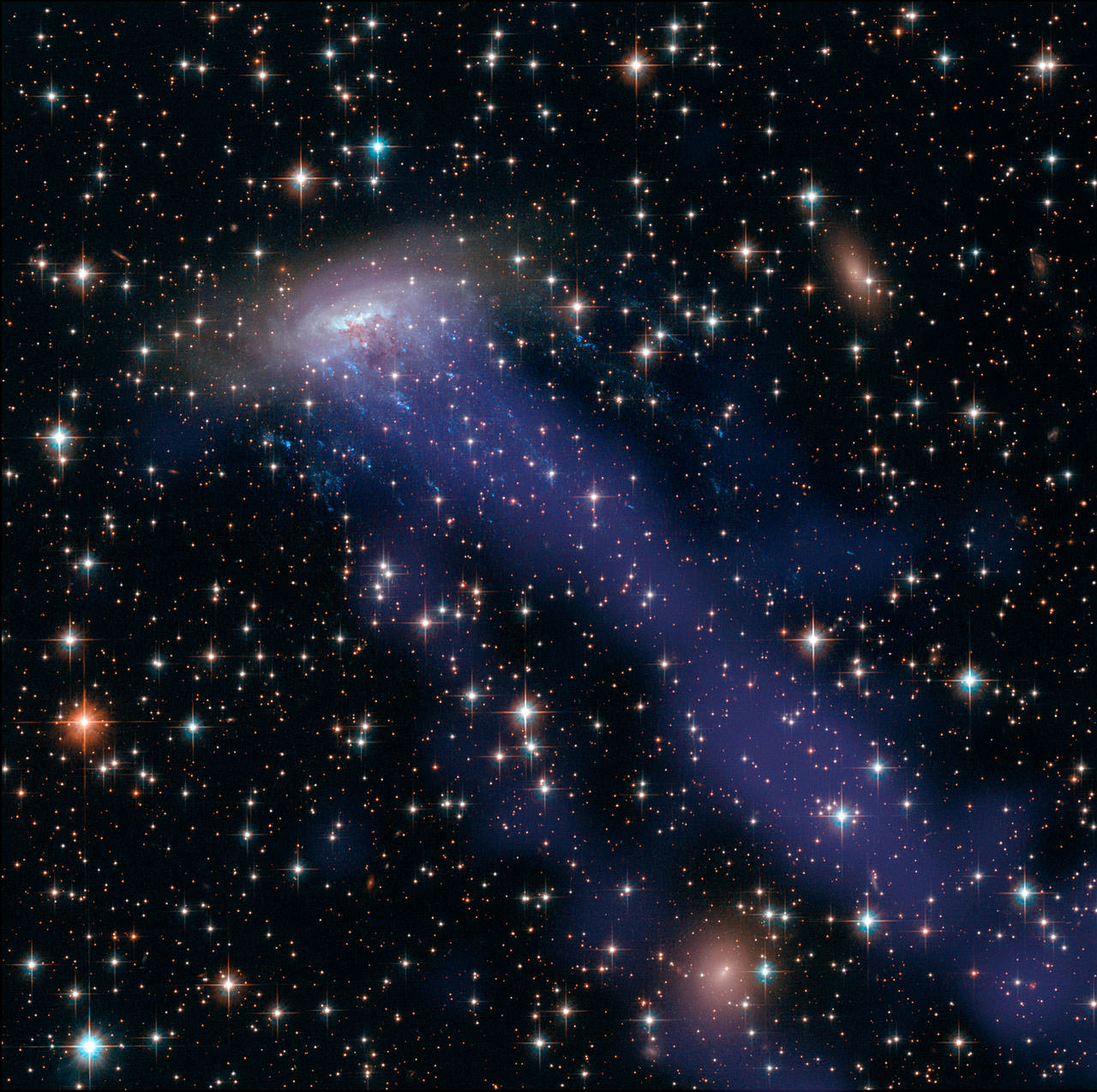
Some galaxies shine with a red ghostly glow. Once these galaxies stop forming new stars, they can only host long-lived stars with low masses and red optical colors. Astronomers often call these ghostly galaxies “red and dead.” But the basics behind why some form so quickly is still a mystery.
“It is one of the major tasks of modern astronomy to find out how and why galaxies in clusters evolve from blue to red over a very short period of time,” said lead author Michele Fumagalli from Durham University in a news release. “Catching a galaxy right when it switches from one to the other allows us to investigate how this happens.”
And that’s exactly what Fumagalli and colleagues did.
The team used ESO’s Multi Unit Spectroscopic Explorer (MUSE) instrument mounted on the 8-meter Very Large Telescope. With this instrument, astronomers collect 90,000 spectra every time they look at an object, allowing them to gain a detailed map of the object’s motion through space.
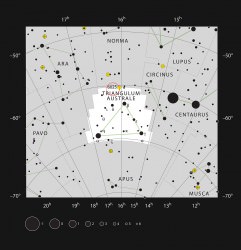
The target, ESO 137-001, is a spiral galaxy 200 million light-years away in the constellation better known as the Southern Triangle. But more importantly, it’s currently hurtling toward the Norma Cluster and embarking on a grand galactic collision.
ESO 137-001 is being stripped of most of its gas due to a process called ram-pressure stripping. As the galaxy falls into the galaxy cluster, it feels a headwind, much as a runner feels a wind on even the stillest day. At times this can compress the gas enough to spark star formation, but if it’s too intense then the gas is stripped away, leaving a galaxy that’s empty of the material needed to form new stars.
So the galaxy is in the midst of a brilliant transformation, changing from a blue gas-rich galaxy to a red gas-poor galaxy.
The observations show that the outskirts of the galaxy are already completely devoid of gas. Here the stars and matter are more thinly spread, and gravity has a relatively week hold over the gas. So it’s easier to push the gas away.
In fact, dragging behind the galaxy are 200,000 light-year-long streams of gas that have already been lost, making the galaxy look like a jellyfish trailing its tentacles through space. In these streamers, the gas is turbulent enough to compress small pockets of gas and therefore actually ignite star formation.
The center of the galaxy, however, is not yet devoid of gas because the gravitational pull is strong enough to hold out much longer. But it will only take time until all of the galactic gas is swept away, leaving ESO 137-001 red and dead.
Surprisingly the new MUSE observations show the gas trailing behind continues to rotate in the same way that the galaxy does. Furthermore, the rotation of stars at the center of the galaxy remains unhindered by the great fall.
Astronomers remain unsure why as this is only a snapshot of one galactic crash, but soon MUSE and other instruments will pry more out of the cosmic shadows.
The results will be published in the journal Monthly Notices of the Royal Astronomical Society and are available online.
Hubble Spots the Ghostly Light From Dead Galaxies
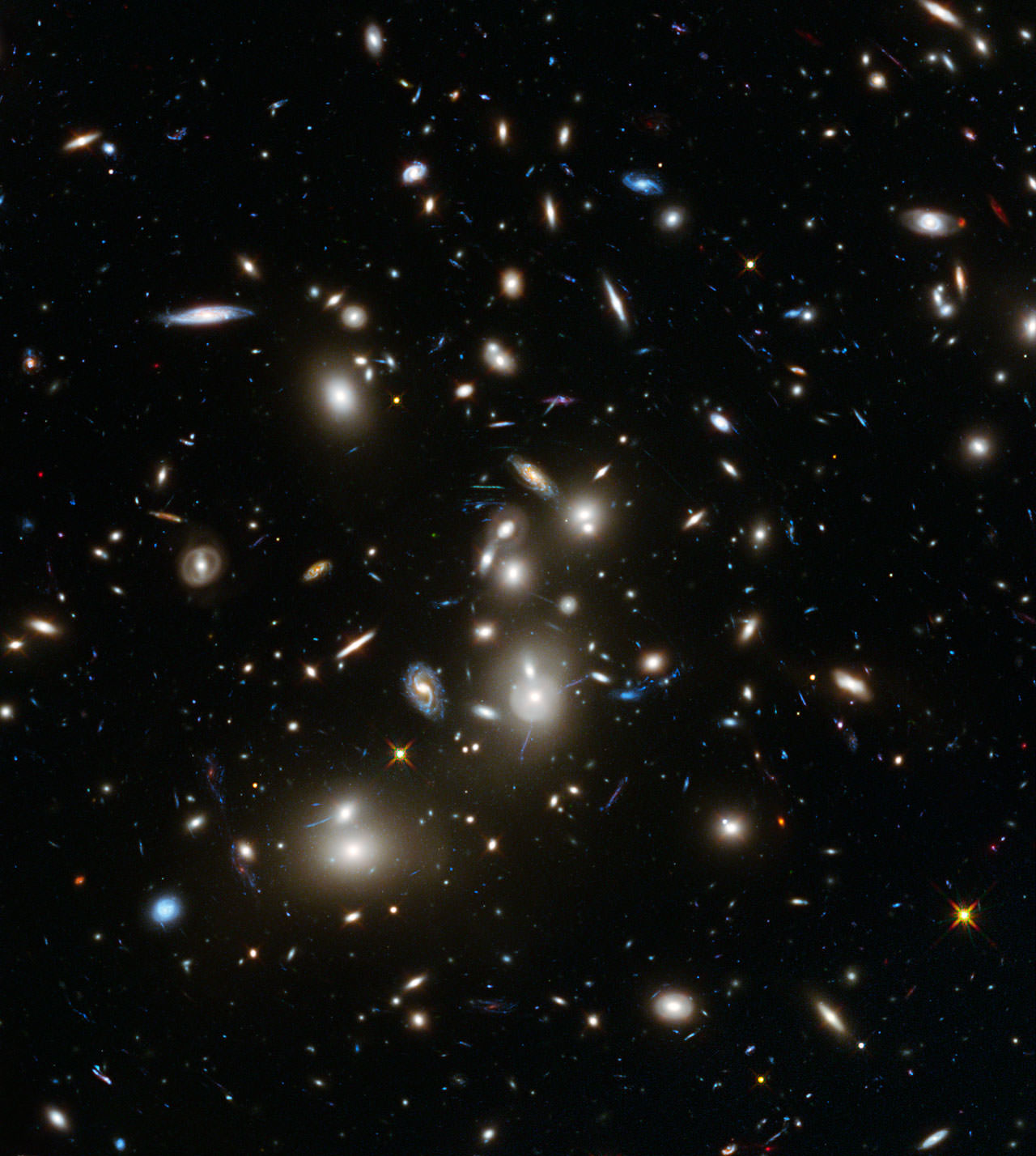
In a patch of sky 3.5 billion light-years away there are hazy elliptical galaxies, colorful spirals, blue arcs and distorted shapes seen clumping together. It’s the result of a vast cosmic collision that took place over the course of 350 million years.
The mess is a treasure trove of information for astronomers, allowing them to piece together the history of a cosmic pile-up of multiple galaxy clusters.
But now astronomers are digging through the nearby darkness. They’re eyeing the remnant stars that were cast adrift in intergalactic space. These stars should emit a faint glow known as intracluster light that — until now — has mostly remained a subject of speculation.
Mireia Montes and Ignacio Trujillo, both from the University of La Laguna, Spain, have used the Hubble Space Telescope to observe the aforementioned cluster, Abel 2744, in exquisite detail. The cluster has already earned the nickname Pandora’s Cluster for its violent past.
The team looked at both visible and near-infrared color images of the cluster, and then split these color images by brightness. This allowed Montes and Trujillo to pinpoint the color of the cluster’s faintest glow and therefore glean the ghost stars’ age, chemical content, and total mass.
Compared to stars within the cluster’s galaxies, the ghost stars emit bluer light and are therefore rich in heavier elements like oxygen, carbon, and nitrogen. So the scattered stars must be second- or third-generation stars enriched by previous supernovae. But they’re still between three and nine billion years younger than the stars within the cluster’s galaxies.
The team estimates that the combined light of about 100 billion outcast stars contributes approximately six percent of the cluster’s brightness.
But how did the stars get thrown from their respective galaxies in the first place? This new forensic evidence suggests that violent collisions tore apart between four and six Milky Way-size galaxies, scattering their stars into intergalactic space.
“The Hubble data revealing the ghost light are important steps forward in understanding the evolution of galaxy clusters,” said Trujillo in a news release. “It is also amazingly beautiful in that we found the telltale glow by utilizing Hubble’s unique capabilities.”
Abell 2744 is only one target in Hubble’s Frontier Fields program, which will map five more galaxy clusters in superb detail.
The results have been published in the Astrophysical Journal and are available online.
Speca – An Intriguing Look Into The Beginning Of A Black Hole Jet
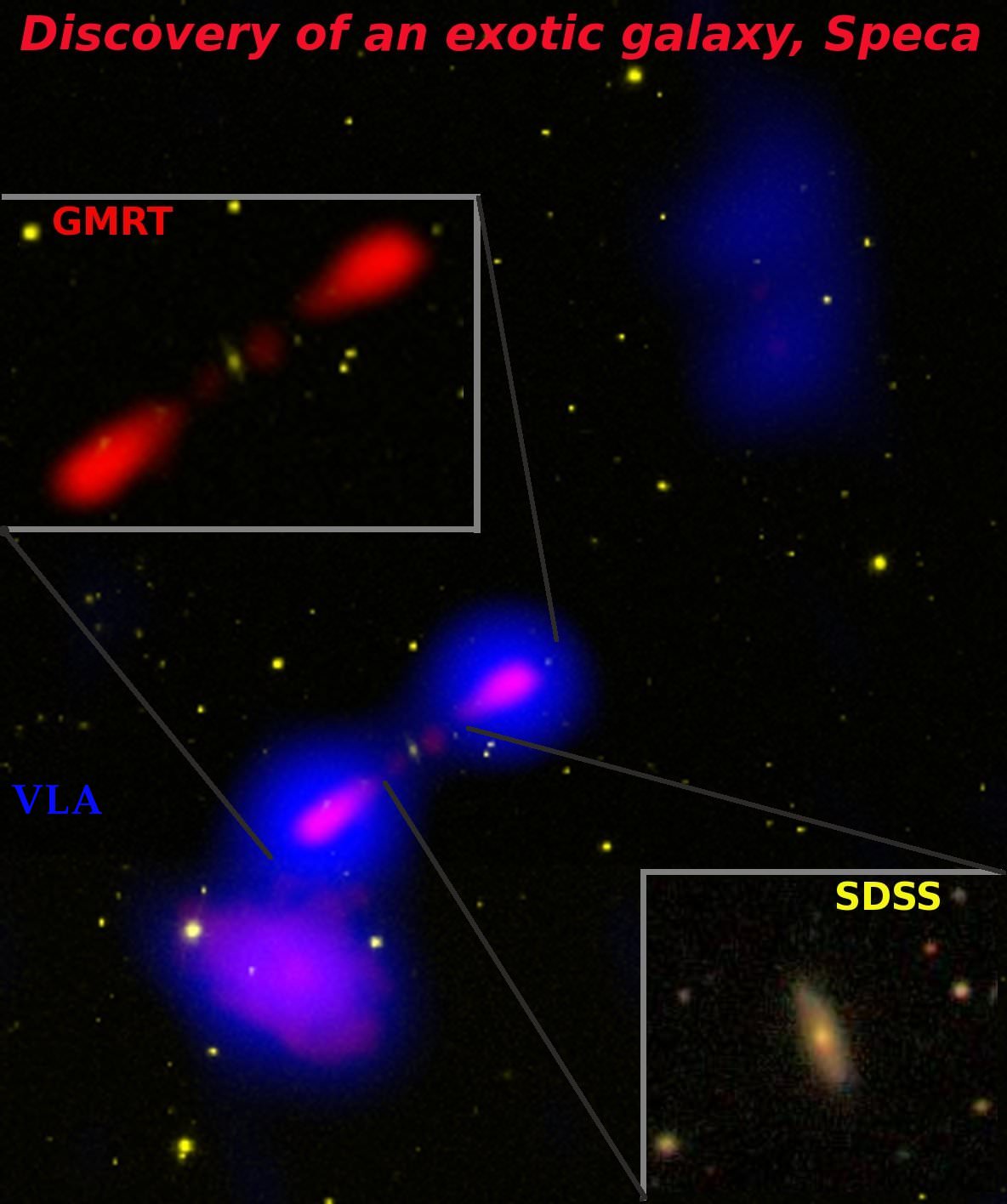
[/caption]
Its name is SPECA – a Spiral-host Episodic radio galaxy tracing Cluster Accretion. That’s certainly a mouthful of words for this unusual galaxy, but there’s a lot more going on here than just its name. “This is probably the most exotic galaxy with a black hole, ever seen. It is like a ‘missing-link’ between present day and past galaxies. It has the potential to teach us new lessons about how galaxies and clusters of galaxies formed in the early Universe,” said Ananda Hota, of the Academia Sinica Institute of Astronomy and Astrophysics (ASIAA), in Taiwan and who discovered this exotic galaxy.
Located about 1.7 billion light-years from Earth, Speca is a radio source that contains a central supermassive black hole. As we have learned, galaxies of this type produce relativistic “jets” which are responsible for being bright at the radio frequencies, but that’s not all they create. While radio galaxies are generally elliptical, Speca is a spiral – reason behind is really unclear. As the relativistic jets surge with time, they create lobes of sub-atomic material at the outer edges which fan out as the material slows down… and Speca is one of only two galaxies so far discovered to show this type of recurrent jet activity. Normally it occurs once – and rarely twice – but here it has happened three times! We are looking at a unique opportunity to unravel the mysteries of the beginning phase of a black hole jet.
“Both elliptical and spiral galaxies have black holes, but Speca and another galaxy have been seen to produce large jets. It is also one of only two galaxies to show that such activity occurred in three separate episodes.” explains Sandeep Sirothia of NCRA-TIFR. “The reason behind this on-off activity of the black hole to produce jets is unknown. Such activities have not been reported earlier in spiral galaxies, which makes this new galaxy unique. It will help us learn new theories or change existing ones. We are now following the object and trying to analyse the activities.”
Dr. Hota and an international team of scientists reached their first conclusions while studying combined data from the visible-light Sloan Digital Sky Survey (SDSS) and the FIRST survey done with the Very Large Array (VLA) radio telescope. Here they discovered an unusually high rate of star formation where there should be none and they then confirmed their findings with ultraviolet data from NASA’s GALEX space telescope. Then the team dug even deeper with radio information obtained from the NRAO VLA Sky Survey (NVSS). At several hundred million years old, these outer lobes should be beyond their reproductive years… Yet, that wasn’t all. GMRT images displayed yet another, tiny lobe located just outside the stars at the edge of Speca in plasma that is just a few million years old.
“We think these old, relic lobes have been ‘re-lighted’ by shock waves from rapidly-moving material falling into the cluster of galaxies as the cluster continues to accrete matter,” said Ananda. “All these phenomena combined in one galaxy make Speca and its neighbours a valuable laboratory for studying how galaxies and clusters evolved billions of years ago.”
As you watch the above galaxy merger simulation created by Tiziana Di Matteo, Volker Springel, and Lars Hernquist, you are taking part in a visualization of two galaxies combining which both have central supermassive black holes and the gas distribution only. As they merge, you time travel over two billion years where the brightest hues indicate density while color denotes temperature. Such explosive process for the loss of gas is needed to understand how two colliding star-forming spiral galaxies can create an elliptical galaxy… a galaxy left with no fuel for future star formation. Outflow from the supernovae and central monster blackholes are the prime drivers of this galaxy evolution.
“Similarly, superfast jets from black holes are supposed to remove a large fraction of gas from a galaxy and stop further star formation. If the galaxy is gas-rich in the central region, and as the jet direction changes with time, it can have an adverse effect on the star formation history of a galaxy. Speca may have once been part of such a scenario. Where multiple jets have kicked out spiral arms from the galaxy. To understand such a process Dr Hota’s team has recently investigated NGC 3801 which has very young jet in very early-phase of hitting the host galaxy. Dust/PAH, HI and CO emission shows an extremely warped gas disk. HST data clearly showa outflow of heated-gas. This gas loss, as visualised in the video, has possibly caused the decline of star formation. However, the biggest blow from the monster’s jets are about to give the knock-down punch the galaxy.
“It seems, we observe this galaxy at a rare stage of its evolutionary sequence where post-merger star formation has already declined and new powerful jet feedback is about to affect the gaseous star forming outer disk within the next 10 million years to further transform it into a red-and-dead early-type galaxy.” Dr. Hota says.
The causes behind why present day radio galaxies do not contain a young star forming disks are not clear. Speca and NGC 3801 are ideal laboratories to understand black hole galaxy co-evolution processes.
Original Research Paper: Caught in the act: A post-merger starforming early-type galaxy with AGN-jet feedback. For Further Reading: Various press releases and news on the discovery of Speca. This article has been changed slightly from its original publication to reflect more information from Dr. Hota.
FourStar Service: Red Galaxy Cluster Hides In Plain Sight
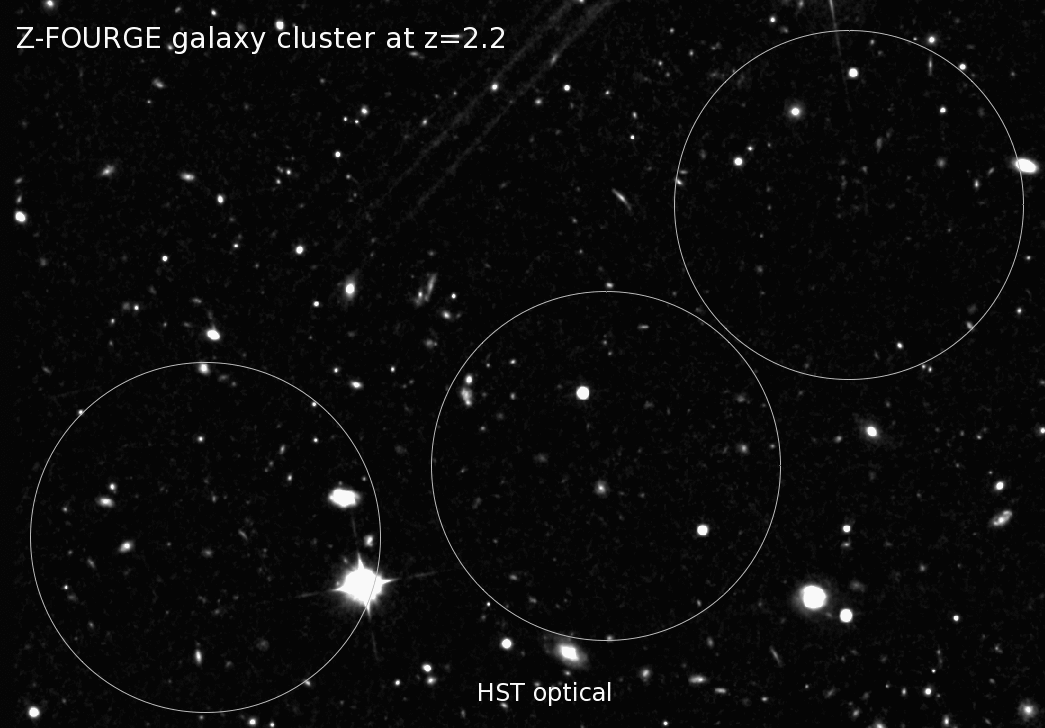
[/caption]
Located some 10.5 billion light years away in the general direction of the constellation of Leo, the most distant cluster of red galaxies so far discovered has been hiding in plain sight… until now. Thanks to the advanced observing techniques of FourStar, a new and powerful near-infrared camera on the 6.5m Magellan Baade Telescope, we’re now able to peer beyond faint and into the realm of the faintest. It’s 30 galaxies packed like sardines in a tin and their formation is the earliest known “galaxy city” in the Universe!
“These are the first steps of accurately measuring the rate at which these large urban cities formed in a dark-matter-dominated universe,” says Texas A&M astronomer, Dr. Casey Papovich. “The rate at which they come together tests our understanding of how structures in the universe formed. The broader the timeline, the better our chances of being accurate. Instrumentation is key, and as it evolves, we’ll keep pushing the boundaries.”
Up until now, this galaxy conglomeration had remained undisclosed – despite thousand upon thousands of hours of survey images taken in their area. It is truly amazing that they were overlooked by the huge ground-based telescopes and space-based research instruments, including the Hubble Space Telescope. There was just no accurate distance estimations until the FourStar project came along. Headed by Eric Persson of the Carnegie Observatories, the stellar team includes Carnegie’s David Murphy, Andy Monson, Dan Kelson, Pat McCarthy, and Ryan Quadri – a group whose findings will be published in the Astrophysical Journal Letters.
Just what is FourStar? It’s a specialized camera set with a group of five very specific filters which are sensitively tuned to a very narrow portion of the near-infrared spectrum. “These new filters are a novel approach; it’s a bit like being able to do a CAT scan of the sky to rapidly make a 3-D picture of the early universe,” says Swinburne’s Karl Glazebrook, who is leading the Australian component of the international collaboration formed in 2009.What sets it apart is its ability to accurately measure distances between Earth and target galaxies one at a time. This allows the program to build an incredible three-dimensional look at the source point.
“Most other surveys were just looking at the tip of the iceberg,” Dr. Kim-Vy Tran explains. “The modern technology contained in this camera enabled us to detect the faintest light possible, allowing us to see much more of the iceberg than previously revealed. It’s like we’re using a comb to sift through the very distant universe. The combination of filters and depth provided by this camera give us the equivalent of more teeth, resulting in better measurements and more accurate results.”
The survey was built one deep over an 11×11 arcminute field each in COSMOS, CDFS and UDS. When it comes to galaxy properties, they are looking at 1-2% accurate redshifts and the current 3-D map is looking back to when the Universe was only 3 billion years old.
“This means the galaxy cluster is still young and should continue to grow into an extremely dense structure possibly containing thousands of galaxies,” explained lead author Lee Spitler of Australia’s Swinburne University of Technology.
The FourStar Galaxy Evolution Survey (“Z-FOURGE”) is just the beginning. Through studies of clusters like this one, astronomers can and will get a better understanding of how galaxy clusters evolve in relationship to their environments and – possibly – how they assemble into larger structures. The survey, led by Dr. Ivo Labbé, a former Carnegie postdoctoral fellow, now at Leiden Observatory in the Netherlands, will also strengthen our abilities to determine distances. In just a half a year, the team “has obtained accurate distances for faint galaxies over a region roughly one-fifth the apparent size of the Moon” locating about another thousand galaxies at even further extents.
“The excellent image quality and sensitivity of Magellan and FourStar really make the difference,” Labbé said. “We look forward to many more exciting and unexpected discoveries!”
Original Story Source: Carnegie Science News Release.
Hubble Captures Giant Lensed Galaxy Arc
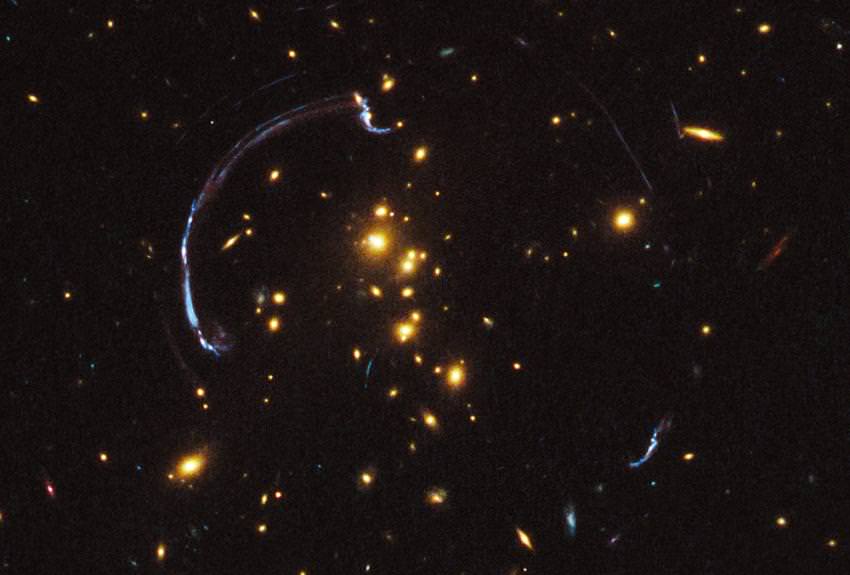
[/caption]
Less than a year ago, the Hubble Space Telescope’s Wide Field Camera 3 captured an amazing image – a giant lensed galaxy arc. Gravitational lensing produces a natural “zoom” to observations and this is a look at one of the brightest distant galaxies so far known. Located some 10 billion light years away, the galaxy has been magnified as a nearly 90-degree arc of light against the galaxy cluster RCS2 032727-132623 – which is only half the distance. In this unusual case, the background galaxy is over three times brighter than typically lensed galaxies… and a unique look back in time as to what a powerful star-forming galaxy looked like when the Universe was only about one third its present age.
A team of astronomers led by Jane Rigby of NASA’s Goddard Space Flight Center in Greenbelt, Maryland are the parties responsible for this incredible look back into time. It is one of the most detailed looks at an incredibly distant object to date and their results have been accepted for publication in The Astrophysical Journal, in a paper led by Keren Sharon of the Kavli Institute for Cosmological Physics at the University of Chicago. Professor Michael Gladders and graduate student Eva Wuyts of the University of Chicago were also key team members.
“The presence of the lens helps show how galaxies evolved from 10 billion years ago to today. While nearby galaxies are fully mature and are at the tail end of their star-formation histories, distant galaxies tell us about the universe’s formative years. The light from those early events is just now arriving at Earth.” says the team. “Very distant galaxies are not only faint but also appear small on the sky. Astronomers would like to see how star formation progressed deep within these galaxies. Such details would be beyond the reach of Hubble’s vision were it not for the magnification made possible by gravity in the intervening lens region.”
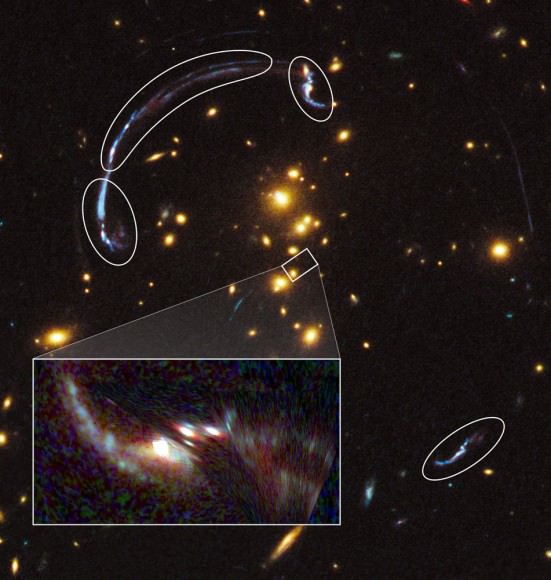
But the Hubble isn’t the only eye on the sky examining this phenomenon. A little over 10 years ago a team of astronomers using the Very Large Telescope in Chile also measured and examined the arc and reported the distant galaxy seems to be more than three times brighter than those previously discovered. However, there’s more to the picture than meets the eye. Original images show the magnified galaxy as hugely distorted and it shows itself more than once in the foreground lensing cluster. The challenge was to create a image that was “true to life” and thanks to Hubble’s resolution capabilities, the team was able to remove the distortions from the equation. In this image they found several incredibly bright star-forming regions and through the use of spectroscopy, they hope to better understand them.
Original Story Source: Hubble News Release.
Emerging Supermassive Black Holes Choke Star Formation
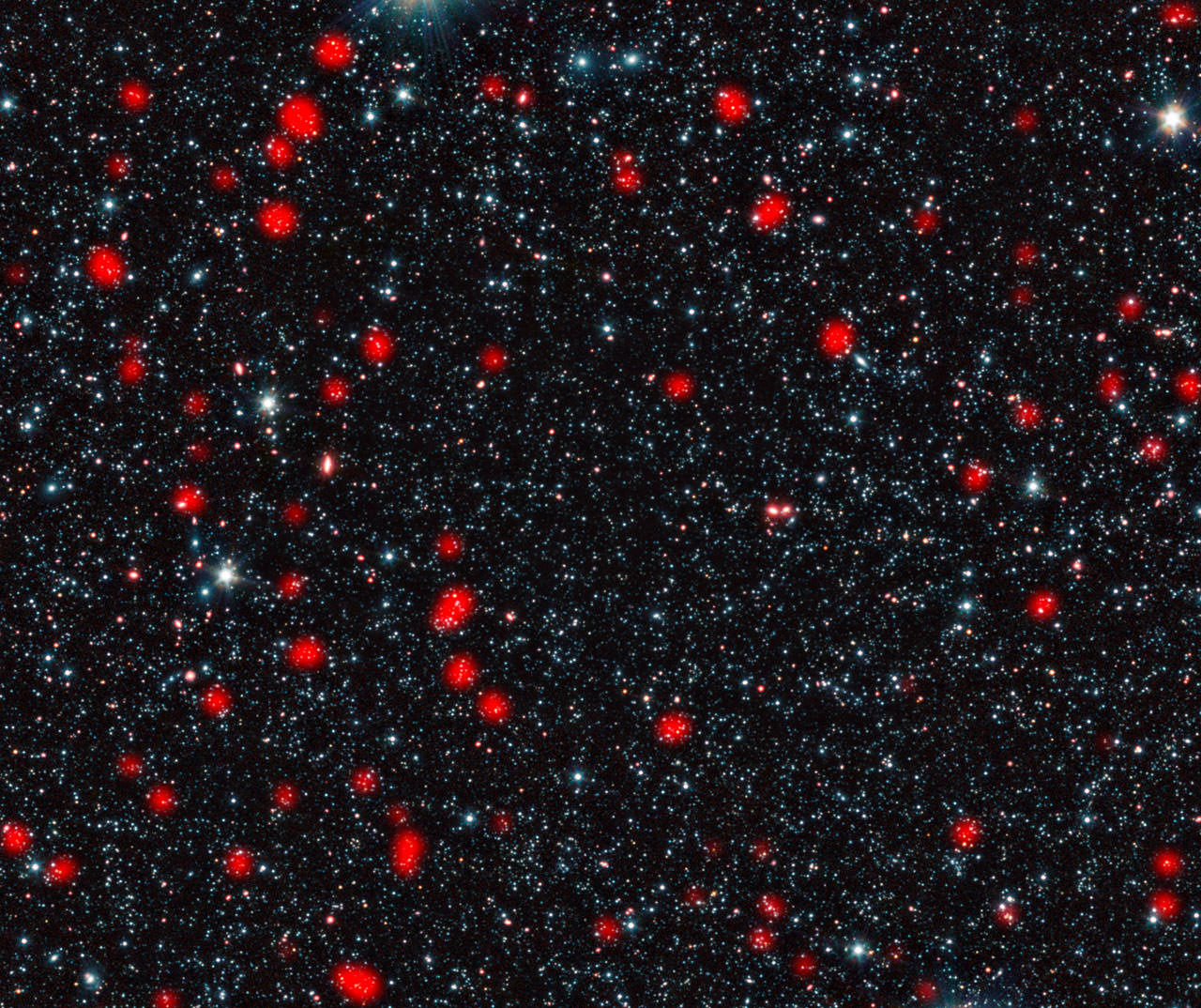
[/caption]
Located on the Chajnantor plateau in the foothills of the Chilean Andes, ESO’s APEX telescope has been busy looking into deep, deep space. Recently a group of astronomers released their findings regarding massive galaxies in connection with extreme times of star formation in the early Universe. What they found was a sharp cut-off point in stellar creation, leaving “massive – but passive – galaxies” filled with mature stars. What could cause such a scenario? Try the materialization of a supermassive black hole…
By integrating data taken with the LABOCA camera on the ESO-operated 12-metre Atacama Pathfinder Experiment (APEX) telescope with measurements made with ESO’s Very Large Telescope, NASA’s Spitzer Space Telescope and other facilities, astronomers were able to observe the relationship of bright, distant galaxies where they form into clusters. They found that the density of the population plays a major role – the tighter the grouping, the more massive the dark matter halo. These findings are the considered the most accurate made so far for this galaxy type.
Located about 10 billion light years away, these submillimetre galaxies were once home to starburst events – a time of intense formation. By obtaining estimations of dark matter halos and combining that information with computer modeling, scientists are able to hypothesize how the halos expanding with time. Eventually these once active galaxies settled down to form giant ellipticals – the most massive type known.
“This is the first time that we’ve been able to show this clear link between the most energetic starbursting galaxies in the early Universe, and the most massive galaxies in the present day,” says team leader Ryan Hickox of Dartmouth College, USA and Durham University, UK.
However, that’s not all the new observations have uncovered. Right now there’s speculation the starburst activity may have only lasted around 100 million years. While this is a very short period of cosmological time, this massive galactic function was once capable of producing double the amount of stars. Why it should end so suddenly is a puzzle that astronomers are eager to understand.
“We know that massive elliptical galaxies stopped producing stars rather suddenly a long time ago, and are now passive. And scientists are wondering what could possibly be powerful enough to shut down an entire galaxy’s starburst,” says team member Julie Wardlow of the University of California at Irvine, USA and Durham University, UK.
Right now the team’s findings are offering up a new solution. Perhaps at one point in cosmic history, starburst galaxies may have clustered together similar to quasars… locating themselves in the same dark matter halos. As one of the most kinetic forces in our Universe, quasars release intense radiation which is reasoned to be fostered by central black holes. This new evidence suggests intense starburst activity also empowers the quasar by supplying copious amounts of material to the black hole. In response, the quasar then releases a surge of energy which could eradicate the galaxy’s leftover gases. Without this elemental fuel, stars can no longer form and the galaxy growth comes to a halt.
“In short, the galaxies’ glory days of intense star formation also doom them by feeding the giant black hole at their centre, which then rapidly blows away or destroys the star-forming clouds,” explains team member David Alexander from Durham University, UK.
Original Story Source: European Southern Observatory News. For Further Reading: Research Paper Link.

